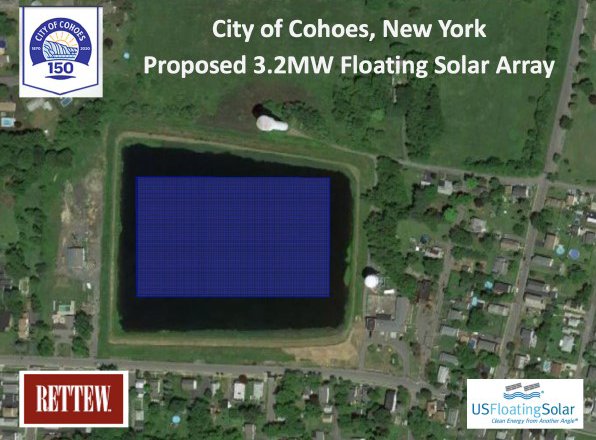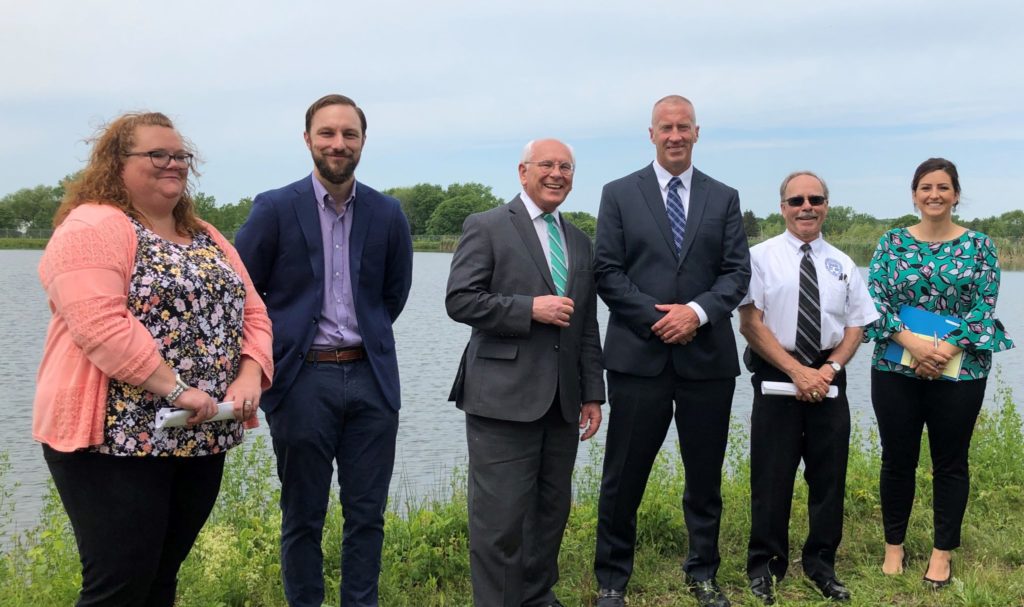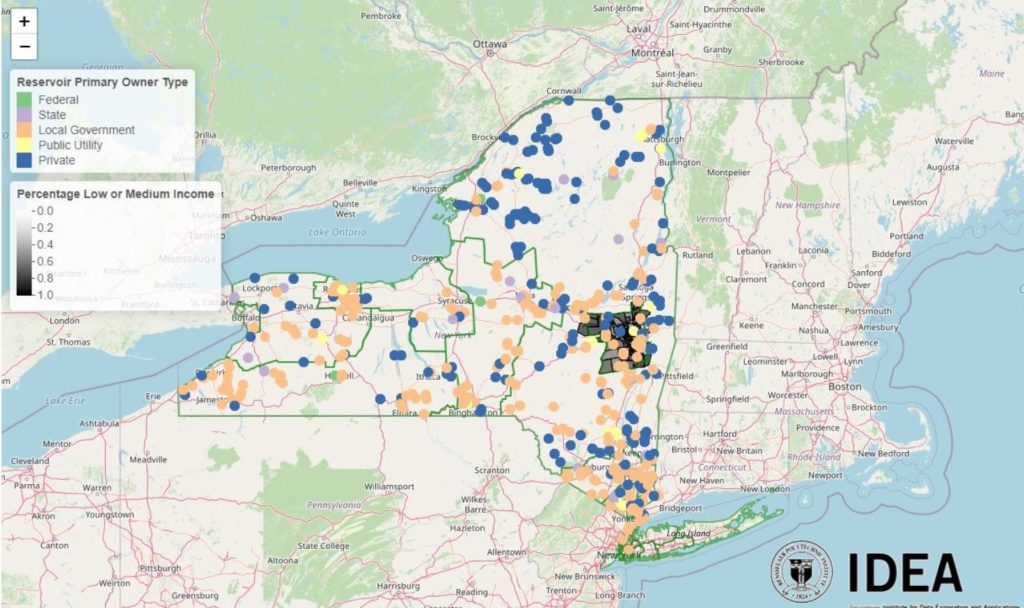Local Government:
City of Cohoes, New YorkProject:
Cohoes Municipal Floating Solar Demonstration ProjectCategory:
On-Site SolarProject Purpose
To build a 3.2 MW municipally owned and operated floating solar project that will provide clean energy to municipal facilities and other civic uses, while educating the public about innovative sustainability projects. The city’s projected savings of electricity costs will be reinvested into other infrastructure, economic development, and community revitalization projects.
Project Overview

The City of Cohoes, a small community in upstate New York of just 17,000 residents, received $3 million in federal funding to construct a floating solar project on a municipally owned, 10-acre water reservoir. The funding will accelerate Cohoes’s efforts to develop one of the few city-owned-and-operated floating solar installations in the United States. The power generated from an estimated 8,000 floating solar panels will meet 100% of the City’s municipal energy demand annually, with the remainder intended to power some school district and housing authority facilities.
The City of Cohoes chose to pursue the relatively novel floating solar, also known as floatovoltaics, because it offers a set of distinct, enhanced benefits to the community. In addition to clean energy generation, floating solar:
- Promotes sustainable land use by avoiding the development of green space or agricultural areas.
- Reduces evaporation rates by decreasing the exposed surface area.
- Improves water quality by inhibiting algae blooms, which reduces the need for chemicals to manage a typically chronic and costly challenge for water reservoirs.
- Offers a highly visible and educational demonstration of clean energy innovation.
In Cohoes’s project proposal, the City leveraged existing resources, research, and partnerships to help strengthen the pitch to federal, state, and local stakeholders. For example, the City drew from a 2018 National Renewable Energy Laboratory (NREL) report that estimated the huge potential of floating solar in the United States. This report also validated the concept for both the City and its stakeholders.
“The NREL study was key for us, providing both confidence that our idea was feasible, and credibility for others that it was a viable idea.”
Theresa Bourgeois, City of Cohoes Director of Operations
In addition, the City collaborated with Rensselaer Polytechnic Institute’s (RPI) Institute for Data Exploration and Applications (IDEA) to visualize NREL’s data on potentially suitable water reservoirs and to overlay that with economic data at the census track level in New York. RPI’s data-driven tool offers energy, site, and income data to further illustrate the potential opportunity for floating solar projects in other small communities with limited budgets like Cohoes.
How was the deal structured?
The municipally owned and operated floating solar project in Cohoes will cost almost $6 million dollars in total, and will, in part, be funded by Congress. Local governments often use a third-party purchasing approach to help overcome upfront costs of projects like these. However, this means municipalities are likely to capture fewer economic benefits from the project in the long term. In this case, Cohoes decided not to enter into a lease or power purchase agreements with a third-party developer.
To date, Cohoes has received $3 million of Community Project Funding to procure, own, and operate the project and realize the full life-cycle economic gains. Cohoes learned of Community Project Funding (previously known as “earmarks”) from its Congressional representative and applied for funding to support this project. In addition to multiple positive impacts, such as attracting energy investment and boosting educational tourism, the City expects $500,000 in annual savings compared with its current electricity costs. Cohoes City Planner Joseph Seman-Graves shared that Community Project Funding and this project would incentivize municipalities to “invest in their own energy infrastructure in a sustainable way, while realizing the full economic benefits of doing so.”
“This project will be transformational for Cohoes, and hopefully for communities all across New York State and around the country. Our city owned and operated floating solar installation will demonstrate that municipalities can generate both clean energy and economic opportunity at the same time. Our project is also generating an ‘oh wow, I had not thought about floating solar’ moment for a lot of people… there’s tremendous untapped potential to generate clean energy, in places people have not thought about, and in ways that have fascinating environmental upsides.”
Joe Seman-Graves, City of Cohoes City Planner
What were Cohoes’s biggest challenges in setting up this project?

Securing adequate funding: Although direct ownership of a floating solar farm provided the most value to Cohoes, the city lacked the financial resources to pursue this structure on its own and wasn’t eligible for tax incentives available to the private sector. Also, very few external funding programs exist for solar energy projects and federal funding always requires a local match, which can create more challenges for small cities and counties.
Determining the feasibility of floating solar: Because floating solar is an emerging technology and there are very few developed projects in the United States, Cohoes had to seek out advice, data, and lessons learned from developers, organizations, and other communities with experience. For instance, Cohoes connected with the Borough of Sayreville, New Jersey, which is home to one of the largest floating solar projects in the country. Cohoes also solicited help from RPI’s IDEA students and staff, who helped build New York’s Floating Solar Explorer tool. This knowledge sharing between public and private stakeholders played a key role in allowing Cohoes to ultimately move forward with this innovative technology.
Creating a strong application for Community Project Funding: To get enough funding to launch this municipally owned and operated project, Cohoes required federal support. Through regular conversations with US Congressman Paul Tonko’s office, Cohoes learned about Community Project Funding and proactively worked with multiple federal, state, local, university, and utility stakeholders to advance the floating solar proposal. However, Cohoes had to prove its competitiveness as a small community — especially because in 2021, each representative was limited on the number of Community Project Funding projects they could submit (up to 10).
What advice would Cohoes give other local governments as they pursue climate action projects?

Embrace a systems-thinking approach: As newsworthy as this project is, floating solar is just one part of the City’s more holistic energy strategy. Cohoes invested in streetlight efficiency first, and then planned the floating solar project to lock in a consistent price, capture additional cost savings, and hedge against future energy market volatility. Now, Cohoes is focused on building restoration, efficiency retrofits, and sustainable downtown revitalization to create even greater positive environmental impacts for the community.
Bring in key players from the beginning: Schedule regular meetings with potential partners, technical experts, and relevant stakeholders — including school personnel, researchers, and elected officials — to discuss the impacts, benefits, and challenges of your projects and get buy-in for your projects. This also offers the opportunity to collect feedback to further refine plans.
Plan ahead for matching funds: Federal grant programs usually require grantees to provide matching funds (i.e., money the applicant needs to bring to the table). Embrace opportunities to repurpose energy savings and other cost efficiencies to meet future match requirements.
Consider Community Project Funding for climate action: Community Project Funding follows a straightforward process and offers an agnostic funding source that can be leveraged for innovative and ambitious sustainability projects.
How does this project fit into Cohoes’s broader climate and community goals?
Despite its small size, Cohoes has been aggressively pursuing a sustainable revitalization strategy, including prioritizing energy efficiency and clean energy. The floating solar project is but one piece of this strategy.
For example, while many municipalities are struggling to urge their utilities to upgrade their streetlights to LEDs, Cohoes purchased 1,597 streetlights from National Grid in 2021 and will complete the replacement by itself. This purchase is expected to save $9 million in electricity costs over 20 years. In anticipation of the savings, the City authorized a $6.6 million Historic Cleaner Greener Cohoes Bond initiative, announced in April 2021. In addition to funding additional efficiency and clean energy efforts, the projected savings will help Cohoes meet its bond payments and local matching requirements for future federal and state grants. Project-related savings will also be reinvested into the community to accelerate sustainable development.
Additional Information and Resources
- Building Floating Solar in Cohoes (City of Cohoes program website)
- Making the Case: Cohoes, NY Municipal Floating Solar Demonstration Project (City of Cohoes program fact sheet)
- Small City Sets Example for Floating Solar, Empowered by NREL Data Set (NREL news story)
- Need Help Advancing Local Climate Action? Try Community Project Funding (RMI article)
- Floating Photovoltaic Systems: Assessing the Technical Potential of Photovoltaic Systems on Man-Made Water Bodies in the Continental United States (NREL report)
- Floating Solar Explorer (Rensselaer Polytechnic Institute’s state mapping tool made in collaboration with the City of Cohoes)
- Federal Funding Opportunities for Local Decarbonization (FFOLD) Tool (ACCC Renewables Accelerator tool)
